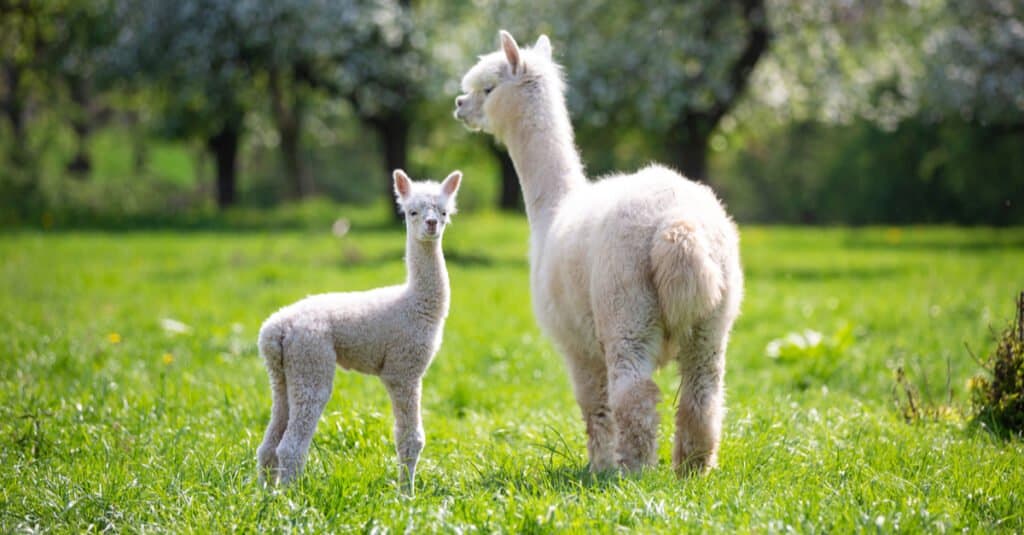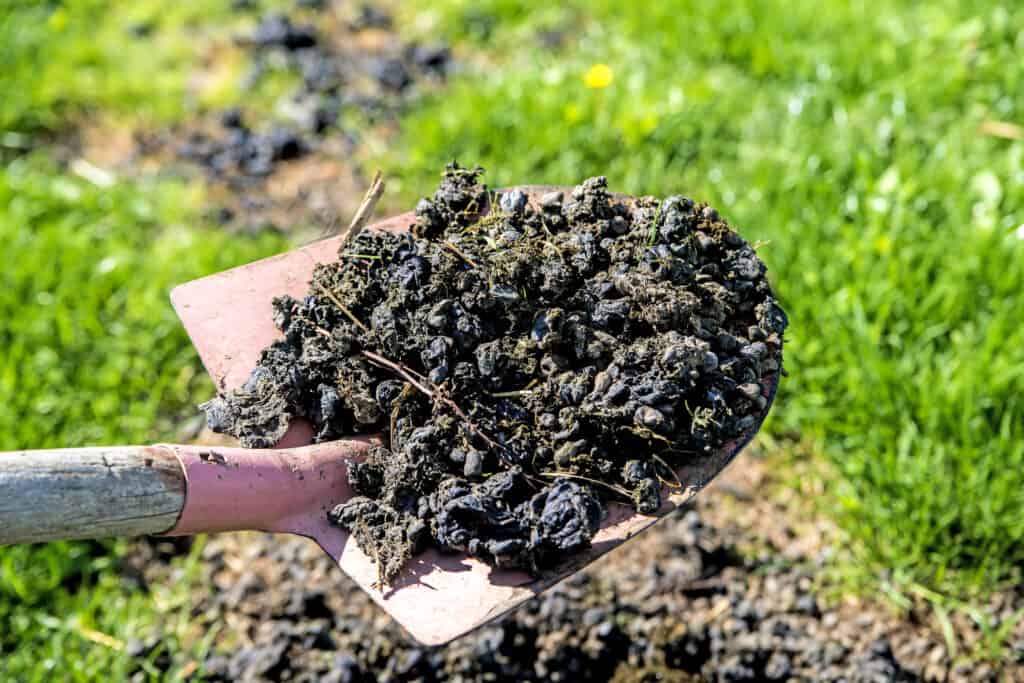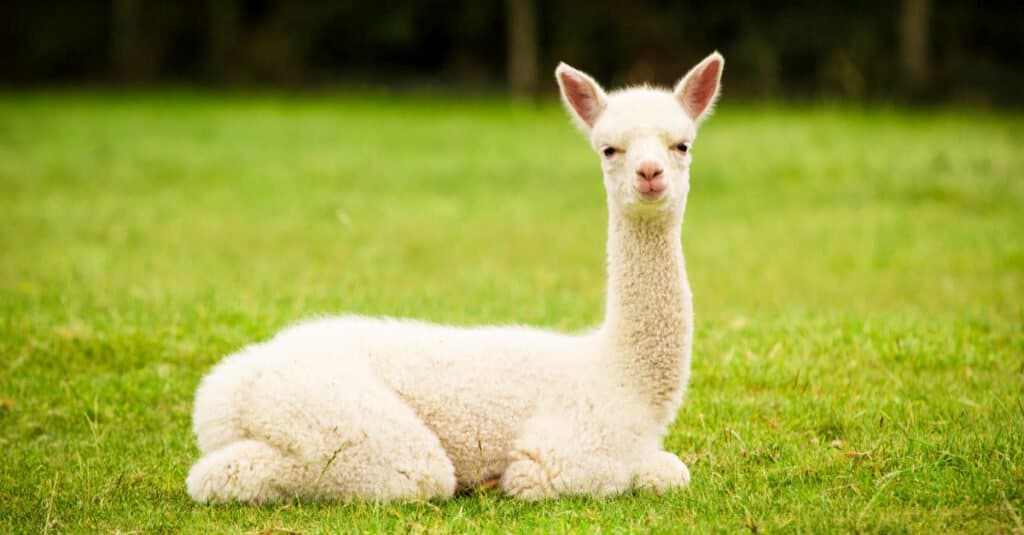Millions of people worldwide are fascinated by these adorable creatures – alpacas! Besides having a cute appearance, they are also extremely interesting creatures. Alpacas have three compartments in their stomach, and poop that makes for an excellent natural fertilizer! Check out this article to learn incredible things about alpacas, their digestive system, and their poop!
What are alpacas?

Alpacas descend from an ancient wild camelid animal called vicugna.
©fotorince/Shutterstock.com
Alpacas are scientifically called Vicuña pacos and descend from an ancient wild camelid animal called vicugna. People often mistake alpacas for llamas because they look similar. The two, however, descend from different animals – the alpaca descends from the vicugna and the llama from the guanaco. Alpacas are classified into two breeds called the Suri and the Huacaya. The Suri alpaca has silky fur with dreadlock-type curls. The Huacaya breed has thick, fluffy fleece suitable for living in cool-temperature habitats.
On average, alpacas are 32-39 inches high and weigh 106-198 pounds.
These animals are social creatures that prefer living in groups. They are intelligent, observant, and quiet. They can sometimes be aggressive, especially when they feel threatened (when a person or another alpaca approaches them from behind, for example).
The largest alpaca herd lives in the Andes Mountains of Peru. However, the animal is now spread worldwide, living on alpaca farms.
Primary alpaca predators include coyotes, bears, maned wolves, gray wolves, dogs, and foxes. When threatened, alpacas produce sounds that can scare off their predators. Spitting is also one of their defense mechanisms against predators.
The average lifespan of the alpaca is 20 years. However, one alpaca is known to have reached 27 years.
What do alpacas eat?
Alpacas are herbivorous animals that eat grass, hay, and sometimes tree leaves. Alpacas don’t eat much – usually 1.5% of their weight per day. When they are pregnant, farmers provide them with additional nutritional supplements.
Even though their diet seems so easy and accessible (it’s just grass, right?!), the grass is, in fact, very difficult to digest because of its fibrous nature. Fortunately, the alpaca’s anatomy has adapted to digesting it. Let’s see how!
How many stomachs do alpacas have?

Alpacas’ stomachs consist of three compartments.
©fotorince/Shutterstock.com
A study shows that alpacas’ stomachs consist of three compartments. Their stomachs have adapted to their feeding behaviors. The fermentation process begins in the first and the second compartments.
Then, in the first part of the third compartment, the nutrients and water are absorbed into the system. The food then goes into the second part of the third compartment, which contains acids that digest the food.
The study also shows that the alpaca’s digestive system differs from the llama’s. While both have a large fermentation chamber, the alpaca’s stomach is bigger than the llama’s.
How do alpacas poop?
Alpacas have communal dung piles they use for pooping. Did you know that they don’t need to be trained to do that? It’s believed this has become one of their natural habits!
Male dung piles are tidier than female dung piles. Females stand in line, patiently waiting to poop. Yes, just like people do with public toilets! They are quite civilized animals, don’t you agree?!
What does alpaca poop look like?

Alpaca droppings are sometimes called beans or pellets.
©iStock.com/HansJoachim
Alpaca droppings look like beans. They are, in fact, sometimes called beans or pellets. These beans are usually oval and of dark colors – dark gray, brown, or black. Alpacas poop in dung piles, which means it’s extremely easy to collect their poop.
How good is alpaca manure?
Depending on what alpacas eat, their manure is extremely useful. Since some alpaca herds feed only on grass, their poop is basically grass in a different form, especially if the grass contains no herbicides or chemical fertilizers. At the same time, alpaca manure has just enough nitrogen to make for excellent fertilizer.
Alpaca poop is known to improve soil texture thanks to its form. It also helps the soil retain water. One of the most convenient advantages is that their droppings do not smell as bad as horse poop.
Is alpaca manure better than other natural fertilizers?

Alpaca droppings have little organic content.
©murbansky/Shutterstock.com
When comparing manures, it’s essential to understand the N-P-K levels of nitrogen, potassium, and phosphoric acid that manure contains. Natural fertilizers usually have low levels of the three. That’s why many gardeners opt for combining a natural fertilizer with an artificial one. Still, natural fertilizers have many benefits for plants and soil.
However, if we compare alpaca manure with horse manure, for example, its N-P-K levels are higher. Moreover, alpaca manure has an optimal temperature, which means the risk of plants getting burned is lower. Why? Because alpaca droppings have little organic content thanks to the animal’s three stomachs.
How to use alpaca poop as plant fertilizer
Gardeners recommend using alpaca poop as plant fertilizer during early spring when plants revive after winter. It’s not advisable to use fertilizer during winter.
If you’re planning to use alpaca manure on plants that produce food, it’s a good idea to compost or heat it first to ensure you reduce the risk of getting pathogens in your food. An easy way to heat the alpaca manure is by leaving it in a hot space for a few days at approximately 140 degrees Fahrenheit. A car left under the sun might be the perfect place for this.
Alpaca manure is considered safe in its natural form because they poop in communal dung piles, which limits the spread of bacteria.
What is alpaca poop tea?
Alpaca poop tea is a liquid substance made from alpaca poop and water at a 1:2 ratio. Mix some alpaca droppings with water and leave it in direct sun for at least a day. However, gardeners say it’s best to leave it for several days, if possible. Once it’s done, add it to a sprayer and use it for indoor and outdoor plants.
Did you know that alpaca manure is one of the few natural manures that can be sprayed directly on plants? Why? Because it doesn’t burn them!
Why do alpacas spit?
Female alpacas might spit to get rid of a male, while males might spit to express dominance. They may also spit if they feel threatened. Basically, they use spitting to get rid of other alpacas’ or to defend themselves.
Up Next:
- Goat Poop: Everything You’ve Ever Wanted to Know
- Camel Poop: Everything You’ve Ever Wanted to Know
- Bison Poop: Everything You’ve Ever Wanted to Know
The photo featured at the top of this post is © murbansky/Shutterstock.com
Thank you for reading! Have some feedback for us? Contact the AZ Animals editorial team.







